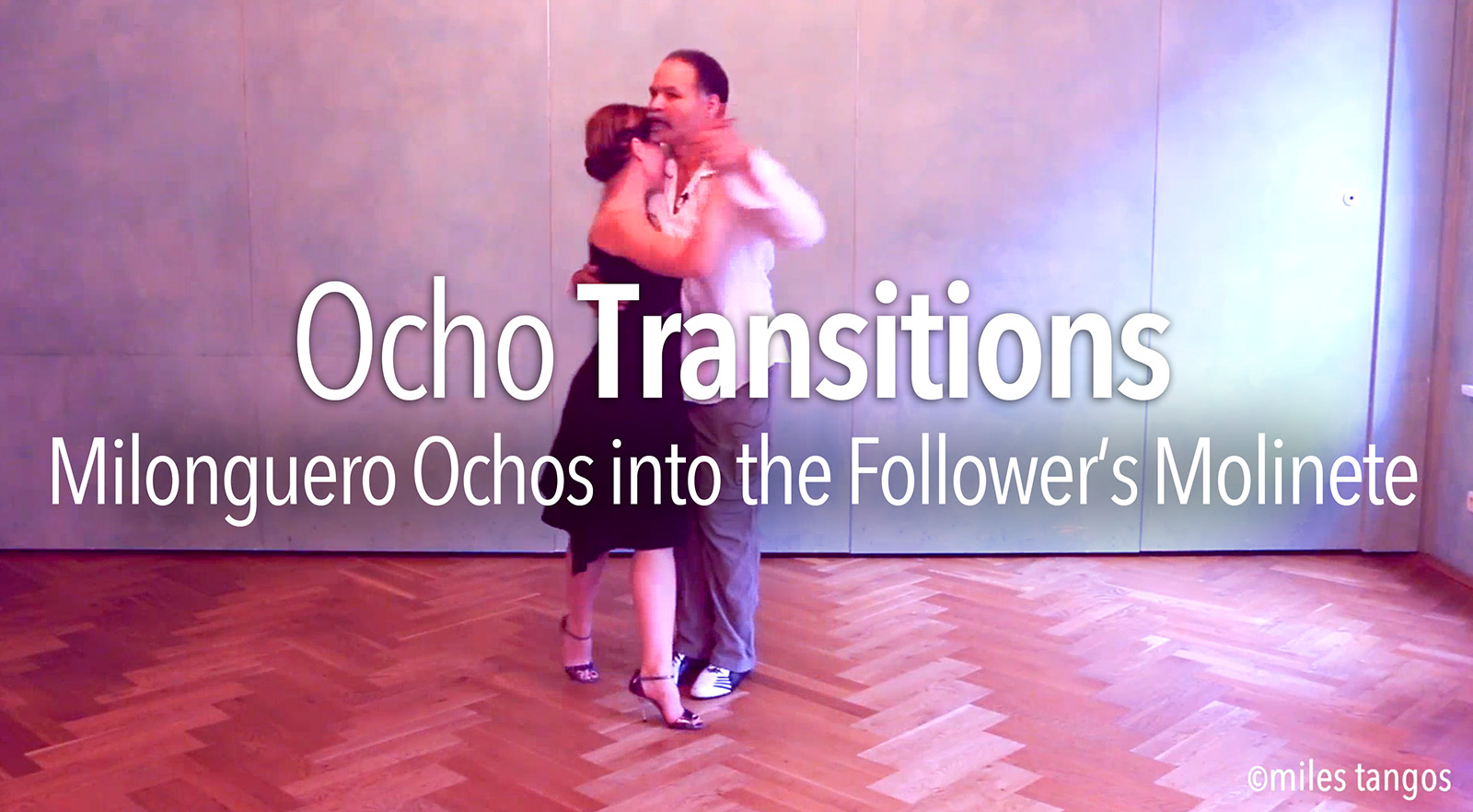Lazy Ochos into The Follower’s Molinete. This is an odd transition to be certain. It mixes two very different types of tango styles or ideas into one way of dancing. Typically the ‘Lazy’ or Milonguero Style Ocho is done in Milonguero style of dancing, that means that the Lead is not leading the Follower’s hips to rotate at all, ever. And then, all of a sudden, and it is all of a sudden, we ask (note the language here…’ask’) the Follower to engage their Molinete. Not a Milonguero Turn, but a Close Embrace Molinete. Talk about confusing! Oy. So let’s get into L/leading and Following Milonguero Ochos into the Follower’s Molinete!
What is an Ocho Transition ? It is exactly what it sounds like. It’s a transition between a commonly used type of Ocho into another commonly used piece of vocabulary. There are 4 types of Ocho Transitions that rely on 2 of the more common types of Ochos. Milonguero Ochos, which are sometimes referred to as “Lazy” Ochos because the hips of the Follower do not rotate. This type of Ocho is absolutely perfect for dancing in a small space, and requires very little effort to lead and very little effort to follow, hence the reason why they’re called “Lazy” Ochos. The second commonly used type of Ocho is the one that everyone is familiar with, these are called “Traveling Ochos” because they do exactly what they say they do, they “Travel” down the line of dance! A Traveling Ocho is where the hips of the Follower do rotate. A Lead will typically engage one or sometimes both of these types of Ochos as a way to transition into another type of vocabulary, usually as a way to lead upto one of the Eight types of turns that are used in Argentine Tango.
What is a Traveling Ocho to Follower’s Molinete Turn ? It’s quite possibly the single most used transition the Tango world, for those that are Dancing with a Lot of Space. This transition employs the Follower’s taught Ocho technique (applied disassociation) to open into their led Molinete! A bit of clarity as to what a ’Traveling’ Ocho is and is not. A ‘Traveling’ Ocho is an ‘Ocho’ that goes down the line of dance. As shown below:
It is one of 8 Ocho types that we use quite frequently, and it is the one that most people think of when you say the word. However, there are others, just so you know! Moving on. What is it not ? It’s not a Lazy Ocho (sometimes rightfully referred to as a ‘Milonguero’ Ocho), nor a Circular Ocho, nor a Linear (just to name a few). No this Ocho, is the venerable one that most Followers are forced to do on day one of Following regardless of whether or not they have been properly trained to do them or not. Usually it’s more the ‘not’ variety than anything else. Why are we talking about ochos ? Because this particular variety of Ocho is so venerable that we use it for nearly every kind of transition there is.
The Free Tip: ‘Marking’ space means that as a lead you’re going to go with the Follower’s rotation, not ahead, not behind, but with. From a Following perspective you’re going to match the speed of the lead’s torso rotation at all points along the curve…stay with them. Don’t let them get ahead of you!
Pre-Requisites: So that we’re all clear on this part, note the difficulty rating below, it is not an exaggeration! You would think this is just walking and turning. That would be a mistake. 1.) You must have mastered your walk first and foremost to the point where you are not using your partner (either lead or follow) for stabilization. 2.) You must be familiar with the Traveling Ocho from a Leading perspective as well as from a Following perspective. 3.) You must have mastered Applied Disassociation. This is not a Pivot! And anyone that tells you differently is taking the easy way out. Applied Disassociation is much harder to do but soooo worth it in the end for a variety of reasons, most notably due to its controlled elegance! 4.) You also must have mastered the Follower’s Molinete from both sides of the embrace. While this transition is a natural extension of both ideas put together it’s important that you have them both clearly in your mind before you attempt to put them together. The reason this video exists is to clean up the issues of the transition itself so that you don’t run into the common problems that most people do when they put these things together.

About The Video. This video is 12:37 in length in 1 section. Lead and Follow technique is co-combined.
The funny (strange, not ‘ha-ha’) thing about this Ocho Transition Series is that it is used more often than you would think. So learning both techniques and tools will help you in the long run as you can use both pieces of vocabulary almost anywhere. From a Following perspective, you’re going to make the mistake of believing that this is all about the Lead. And that’s not the case here. You really do want to understand the Milonguero Turn for you, because the question will come up as it always does, when would I do engage one turn over the other ? And who’s actually leading the turn, the Lead or the Follower ? And the answer is a little bit of both in today’s Tango world.


